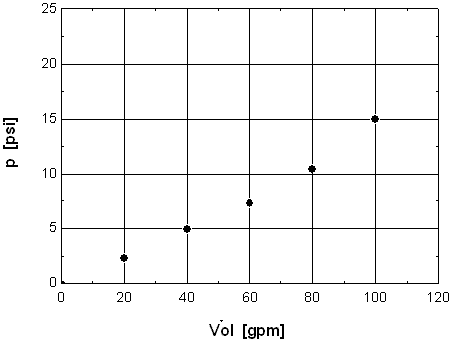ROSE-HULMAN Institute of Technology
Department of Mechanical Engineering
Homework 6
Problem 1
The following data were gathered during pump testing for a certain pump.
- Required torque input = 35 ft-lbf
- Rotational speed = 3600 rpm
- Inlet pressure = 2.5 psia
- Outlet pressure = 30 psia
- Volumetric flowrate = 1000 gpm
- Height to inlet pressure gage = 2 ft
- Height to exit pressure gage = 5 ft
- Inlet flow line: 10 nominal schedule 40 pipe
- Outlet flow line: 8 nominal schedule 40 pipe
- Fluid: Octane (n-octane)
Find the power that reaches the fluid, the power input to the pump itself, and the pump efficiency.
Problem 2
Rather than use the pump tested in Problem 1, select a pump from Fig. 1 to use for the same flow conditions.

Figure 1: Composite rating charts for The Goulds 3196 family of pumps. (www.goulds.com)
Problem 3
A cooling loop for hydraulic fluid (MIL-M-5606) consists of:
- A heat exchanger whose curve of pressure drop versus flow rate is given in the Fig. 2.
- 150 ft of 3-in.schedule 80 pipe + 4 standard elbows ahead of the exchanger.
- 150 ft of 3-in. schedule 80 pipe + 4 standard elbows after the exchanger.
- 1 gate valve.
The fluid enters the exchanger at 200°F and leaves at 80°F. The loop leaves and enters the heat exchanger at the same level. The outlet reservoir has a sharp entrance, and an inlet reservoir is present. The system has a Goulds 1 ½ x 3-8 pump [characteristics given in Fig. 3] that runs at 1,750 rpm. The pump has an 7 ½-in. rotor. For this system
- Plot the required head (in ft) versus volumetric flowrate (in gpm) for the loop with the gate valve fully open.
- Find the operating point for part (a)

Figure 2: Heat exchanger pressure loss

Figure 3: Goulds pump characteristics (www.goulds.com)


